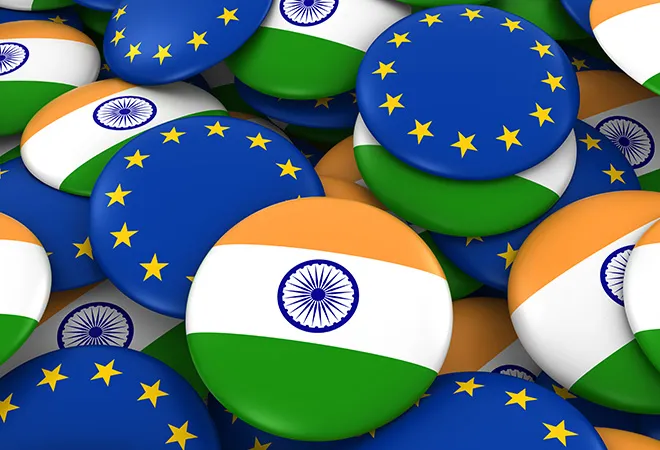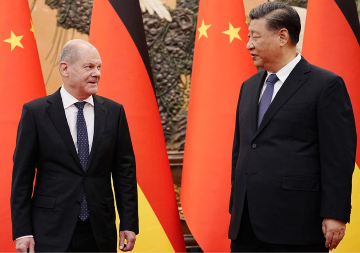
Dating back to the Cold War era, India and the Central and Eastern Europe (CEE) region have shared
special historical, social, political, cultural, and trade ties. Owing to India's proximity to the erstwhile USSR, the communist regimes of Central and Eastern Europe cherished cordial relations with socialist India. This was apparent with CEE countries supplying
military equipment, assisting in the construction of
steel factories and
power plants, and also extending political support to India. However, following the Soviet disintegration, the trade and political ties between India and CEE region took a new turn with India focusing more on Western Europe. However, over the past two decades, India has sought to diversify its trade and investment relations within Europe.
India’s course-correction
In the post-Cold War timeline, when it came to India’s engagement with Europe, it was largely with the Western subregion of the continent. This often included powers of ‘
Old Europe’ such as France, Germany, the UK, and the Brussels-centred European Union. India long ignored the massive potential of cultivating ties with the Central and Eastern European region. Apart from the disintegration of the Soviet Union, this oversight was also due to India’s turn towards a liberal market economy in the early 1990s.
However, amidst the opportunities of the 21
st century, India and the Visegrád Group also known as the V4 countries (Czech Republic, Poland, Hungary, Slovakia) steadily reinvigorated their ties. After all, these countries emerged among the
fastest-growing economies in the European Union. With a total GDP of
529 billion euros, Poland is the
seventh-largest economy in the EU. Between 1992–2019, its pace of average growth stood uninterrupted at
4.2 percent per annum. As per the 2020
economic growth projections of the EU Commission, Poland, Hungary, Czech, and Slovakia are expected to grow at
4.1 percent,
4.6 percent,
2.7 percent and
2.5 percent.
Amidst the opportunities of the 21st century, India and the Visegrád Group also known as the V4 countries (Czech Republic, Poland, Hungary, Slovakia) steadily reinvigorated their ties.
An Indian approach to CEE centred on the V4 did not only seek to revise trade linkages, but also sought to correct the deficit of visits to the region. In 2019, it was after a long gap of 32 years that the Indian Foreign Minister
visited Warsaw, and he visited Budapest after a gap of six years. However, the subregion’s transformation not only meant an expansion of political and business exchanges, but also a renewed India-CEE synergy at various levels. Like, for instance, the V4 and Eastern European countries have shown unequivocal support for
India’s bid for a permanent seat on the United Nation Security Council (UNSC) and the Visegrád group has also shown
support for India’s Nuclear Supplier Group (NSG) membership.
New synergies
With the Czech Republic, trade ties gained momentum when the payments were switched to freely convertible currencies followed the signing of the
Bilateral Investment Promotion Agreement (BIPA) in 1996. Amidst its
rising discord with China,
sanctions regime with the Russian Federation, and India’s expanding footprint globally, Prague recently also included
India among the 12 priority countries that it seeks to deepen relations with. Furthermore, India and the Czech Republic are
boosting ties in the defence sector, with New Delhi’s
invitation to Prague defence companies for setting up joint ventures as a
crucial partner in next-generation technology. In addition, a contract was
signed by Czech-based PBS to produce aircraft engines in India in 2020. In tandem, prominent Indian companies across various sectors now hone a footprint in the Czech Republic. Some examples being Infosys, Ashok Leyland, Glenmark Pharmaceuticals, and Lloyd Electric and Engineering Ltd.
Post-1947, Hungary also emerged as one of the first countries from the Warsaw Pact that emphasised political and business
relations with India. However, efforts to intensify trade ties
failed on many occasions. It was only after the economic liberalisation in India and democratic transition in Hungary that the two partners’ trade linkages witnessed a fillip. By 2015, the Hungarian Minister of Foreign and Trade could then confidently deem that the bilateral economic cooperation will
“enter an extremely dynamic phase of development.” This was underpinned by a strong presence of Indian companies in Hungary, and New Delhi being termed as a ‘priority partner’ by Budapest. New Delhi–Budapest trade ties continue to
witness an upward trajectory (pegged at
US $750 million in 2020) and Indian companies like TCS, Genpact, Sun Pharma, Crompton Greaves, SMR, and Orion are prominent investors in Hungary. Between 2014–2015,
Apollo Tyres and
SMP-Group were also the largest investors in Hungary’s greenfield projects.
Similarly, India established
diplomatic ties with Poland as early as 1954. However, the breakthrough in these ties occurred as recently as 2014, when New Delhi and Warsaw
celebrated the 60th anniversary of their diplomatic relations. Poland has deemed India to be its
“priority” non-European partner
only after China. Trade between New Delhi and Warsaw has
grown seven-fold crossing over
US $3 billion in 2017. Moreover, the 2018 launch of the
Polish Investment and Trade Agency’s Foreign Trade office in Mumbai was followed by the launch of
direct flights between New Delhi and Warsaw by
Polish Airlines LOT in 2019.
Going forward, there are new areas of cooperation that can boost the overall trade ties between India and Poland. These areas include corporate finance and IT services, food and agro-processing technologies, renewable energy, cybersecurity, FinTech, etc. In addition,
Punjab–Lubelskie,
Andhra Pradesh–Malopolska, and
Maharashtra–Weilkopolska are some of the prominent examples of subregional cooperation between India and Poland. Not to mention, India and Poland share strong linkages on the international stage. It was Poland that
sponsored the UNSC Resolution 1267 <2019> to impose a ban on Jaish-e-Mohammad. Similarly, Poland showed
unequivocal support for India’s position on Kashmir post the abrogation of Article 370.
Finally, Slovakia sees India as an
important country with rising international legitimacy and major economic potential. In 1993, RL Bhatia was the first non-European Foreign Minister to visit Bratislava. Slovakia
aims to develop an intensive political dialogue to harness the wider economic cooperation. However, India’s trade
relations with Slovakia continues to lag. But India has shown
the inclination to invest in its automotive sector, with Tata’s Jaguar Land Rover establishing Europe’s
largest Indian-owned personal car plant in Slovakia.
Beyond these convergences with the V4, India’s relations with the broader CEE countries—which includes other potential partners like Austria, Croatia, Serbia, Slovenia, Romania, Ukraine, and even the Baltic states—demand attention. An Indian approach to CEE centred only on the V4, belies the vast potentialities of India’s relations with Europe.
Beyond these convergences with the V4, India’s relations with the broader CEE countries—which includes other potential partners like Austria, Croatia, Serbia, Slovenia, Romania, Ukraine, and even the Baltic states—demand attention
Brussels’ neglect
Another factor impeding greater India–CEE cooperation is the EU’s apparent neglect of its eastern subregion. There is no denying that
“Carolingian Europe” nostalgia continues to figure in the CEE region’s view of Europe. Whereby, it is the common public perception that major policy decisions within the EU are still
controlled by Western EU countries like France and Germany. Even after 17 years of accession to the EU, an assessment of broader sentiments of the CEE region reveals that the West is still
not ready to accept their values.
Further attesting to this inherent threat to European solidarity is the recently published
Conference on the Future of Europe that didn’t even mention the significance of the CEE region. Remarks by Milena Lazarevic (Programme Director and Co-founder, European Policy Centre, Serbia) at the Raisina Dialogue 2021
affirmed the exclusive nature of the EU’s policy decision-making. There is a pressing need to incorporate diverse voices of the CEE region rather than denouncing or ignoring them. In citing the Conference on the Future of Europe, Lazarevic
stressed that the EU should also not forget the strategic importance of the region given the region’s increasing dependence on China due to “
lack of EU solidarity”.
Therefore, to fully harness the benefits of the India–EU multi-faceted relationship, it will be in the interest of both partners to relinquish their benign neglect of the CCE region. The recently concluded
India–EU Leaders Level Summit indicated shared commitment to build on connectivity initiatives. Hence, it would be in the common interest of India and the EU to also adopt an inclusive approach for the CEE region within the scope of the India–EU partnership. Subsequently, in the long-term, as cooperation between India and the European Union moves from strength to strength, this will serve as the groundwork for India and the EU to accord a strategic dimension to their engagements with the Central and Eastern European region.
The views expressed above belong to the author(s). ORF research and analyses now available on Telegram! Click here to access our curated content — blogs, longforms and interviews.



 Dating back to the Cold War era, India and the Central and Eastern Europe (CEE) region have shared
Dating back to the Cold War era, India and the Central and Eastern Europe (CEE) region have shared  PREV
PREV

